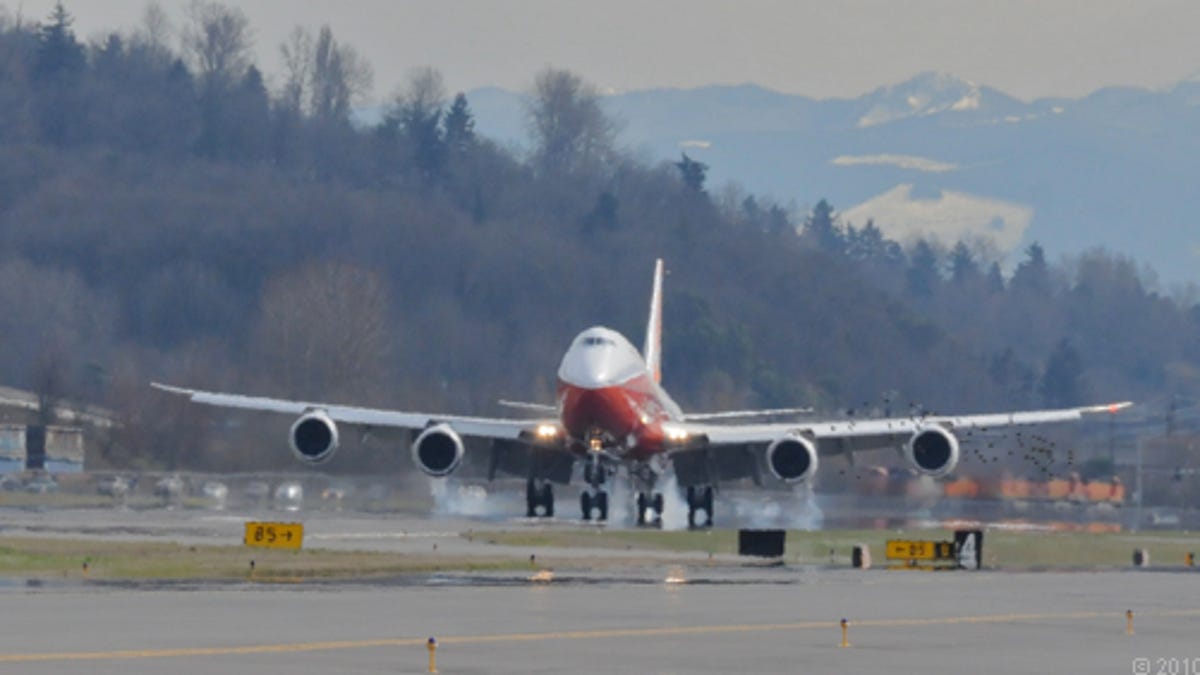Boeing's 747-8 touches down for the first time
Before thousands of fans and company heavyweights at Seattle's Boeing Field, the aviation giant's next-generation 747 made its first landing. Now comes a wide variety of tests and, the company hopes, first commercial delivery later this year.

SEATTLE--With the beautiful snow-covered mountains of Washington state behind it, Boeing's 747-8 Intercontinental made its first-ever landing today, four-and-a-half hours after taking off on its maiden flight.
The flight went about as well as could be expected, 747 chief pilot Mark Feuerstein said in a brief press conference at Boeing Field here, minutes after the plane touched down at 2:25 p.m. PT.
The plane, with its unique red, orange, and white livery, took off at 9:58 a.m. PT from Paine Field in Everett, Wash., and headed immediately toward the Olympic Peninsula, Feuerstein told the crowd gathered for the landing celebration, and then ultimately out to the tip of Washington state.
Along the way, he and co-pilot Paul Stemer took the plane, which is Boeing's longest, fastest, and in theory, most fuel- and cost-efficient ever, up to 20,000 feet and to 250 knots. They also flew it as slow as 105 knots during some of the approaches to stall tests. During the flight, they worked on a series of tests, including simple approaches to stalls, a couple of directional stability tests, and some functional checks of the airplane's systems. And, Feuerstein reported, everything went well, and the plane is "actually ready to go fly right now."
Although Boeing made the first flight of the 747-8 freighter on February 8, 2010, it waited until today to put the passenger version of the plane in the air. But Feuerstein said that, from the pilot's perspective, the wait was worth it. During the interim, Boeing implemented many changes and upgrades to the five 747-8 freighters in its test fleet. But while each of those planes has had a slightly different set of updates, the Intercontinental has benefited from all the various changes made as part of the freighter program. "The changes we've made on the freighter have been rolled into this airplane," Feuerstein said of the Intercontinental. "All those changes have been rolled into one airplane."
One test that he and Stemer put the Intercontinental through today was what he called a "steady heading side slip," which involves putting "the rudder all the way to the floor, and keeping the airplane tracking in the same direction by rolling the airplane," Feuerstein said. Essentially, that means they were flying the plane "sideways, but in a straight line." The idea is that seeing how it performs in such a test "tells us a lot about how it behaves...fortunately, it didn't surprise us at all."
Now that the first flight of the Intercontinental has been completed, Boeing plans on conducting about 600 hours of flight testing throughout the summer and fall, said Elizabeth Lund, the vice president and general manager of the 747 program. Then, sometime in the fourth quarter, she added, Boeing hopes to make its first customer delivery of the plane.
Boeing bills the new 747-8 as the next-generation of its most iconic plane and as the most fuel- and cost-efficient passenger aircraft it has produced. One major highlight is its new wing design. Created using what Boeing calls "the latest in computational fluid dynamics validated in the world's most sophisticated wind tunnels," the all-new wings are said to offer better aerodynamics and improved fuel capacity, while also allowing the plane to be as fast as, or faster than, any other passenger aircraft in the world.
The new wing design sports "fly-by-wire spoilers and ailerons that make it possible to incorporate a flight control feature known as a maneuver load-alleviation system," Boeing said. "Pioneered on the 787 Dreamliner, it changes the lift distribution over the wing during nonnormal flight conditions, reducing the load on its outboard portion." This means a smaller wing structure that is 1,400 pounds lighter than that used on the 747-current-generation 747-400, while not compromising structural integrity.
Boeing is aggressively touting the plane's economic and green credentials: it is the only passenger plane in the 400- to 500-seat market, its four General Electric GEnx 2B engines use 16 percent less fuel per seat than those on the 747-400 and 11 percent less than does Airbus' giant A380.
This is all possible, Boeing said, because of its use of advanced materials in the construction and design of the plane, as well as its use of the GEnx engines, and the form factor and materials of its wings. While most of the plane is made from new aluminum alloys, it also incorporates graphite composites in the rudder, spoilers, flaps, and other areas.
As designed, the 747-8 Intercontinental will carry 467 passengers in a three-class configuration and has a range of 8,000 nautical miles. The freighter version of the 747-8 can fly up to 4,390 nautical miles. The Intercontinental has a wing span of 224 feet, 7 inches, and is 250 feet, 2 inches long. Its tail towers to 63 feet, 6 inches high. And its four GEnx-2B67 engines produce 66,500 pounds of thrust. The passenger plane's top cruising speed is Mach 0.86, while the freighter can fly at Mach 0.845.

